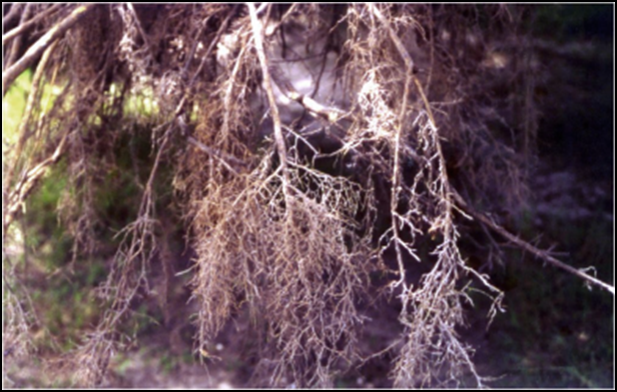Historically, hurricanes in 2004-2005 and periodic tropical storms have caused extensive wind and flooding damage. Even before Hurricane Irma, heavy rainfall in late August created saturated soil conditions in many citrus groves in Southwest and South Central FL. From September 9-11, Hurricane Irma produced excessive rainfall over nearly all areas of the citrus industry. In some areas, rains were so heavy (greater than 15 inches) that it was not possible to move water from the grove into ditches and canals rapidly enough to prevent localized flooding (Figure 1).
Flooding Injury
When water is removed quickly, flooding injury may be minimal. However, potential for water damage to citrus trees increases if water stands over the crown of the tree root system for four or more days under summer temperature conditions (85-95°F). Root injury may occur even when the water table remains just a few inches below the soil surface because soil pores filled with water create a lack of oxygen (anoxia) in the root zone which allows anaerobic bacteria to develop rapidly. Under these conditions, toxic sulfides produced by these anaerobic sulfur-reducing bacteria can build up quickly and kill roots. Ironically, one of the symptoms of excess water is leaf wilting. This occurs because flooding induced anoxia increases root resistance to water uptake. Inadequate aeration decreases water absorption but, transpiration, or the loss of water vapor from leaves, continues. Hence, in hot summer conditions, tree canopy water loss can be greater than water uptake through the roots and wilting occurs. Other symptoms of flood injury include leaf yellowing, chlorosis, fruit drop, leaf drop, and twig dieback. Trees with severely damaged root systems from flooding may fail to recover, remaining stunted or decline.

In most flatwoods soils, a clay or organic layer within 20-48 inches of the surface acts as a barrier to downward movement of excess water. As a result, water must move laterally to be drained from saturated soils. The rate at which water moves through soil is expressed in units of distance/time (in/hr or ft/day) and is called hydraulic conductivity. Sands typically have saturated hydraulic conductivities of 20 inches per hour or more, while the saturated hydraulic conductivity of many flatwoods soils with clay layers is in the range of 0.1-0.2 inch per hour.
Root Injury
Flooding damage can be determined by digging into the soil and smelling root and soil samples. Sour odors or a rotten-egg smell (indicating hydrogen sulfide)

is a sign that fibrous roots are damaged. Vegetative material buried during bed construction can provide the energy source for anaerobic bacteria to reduce sulfates to sulfides. Oxygen deprivation as well as toxic sulfides both contribute to the outright destruction of citrus fibrous roots. Roots are dark brown (Figure 2a and 2 b) and slough when pinched between the finger and thumb.

Monitoring the Water Table
Water table monitoring wells are a good tool for observing soil-water dynamics (Figure 3). They are the most reliable method for evaluating water-saturated zones in sites subject to chronic flooding. Growers can use these wells to measure the rate of water table drawdown. Observation wells constructed with float indicators enable the grower to estimate water table height while driving by the well site. Local offices of the National Resource Conservation Service (formerly USDA Soil Conservation Service) can assist with water table observation well construction and monitoring.

Once excess water has drained and if root damage has not been excessive, trees can begin recovery by regenerating fibrous roots and re-establishing the balance between roots and shoots. Huanglongbing (HLB) damages the very same roots so HLB is very likely to slow regeneration of the fibrous roots system and restoration of the balance between roots and foliage. As recommended for HLB affected trees, efficiency of fibrous roots for water and nutrient uptake is promoted by frequent, short duration applications of irrigation and fertilizer. If wilting of the canopy is visible, trees recovery may be improved by light hedging and topping.
Although flooding may exacerbate Phytophthora root rot, anoxia and toxic sulfides are more likely to kill roots over the short term than Phytophthora. Over the longer term, flooding events may elevate the activity of Phytophthora. Therefore, as fibrous roots regenerate it is essential to minimize water stress (deficit or excess) by monitoring irrigation frequency and duration and measuring water table fluctuations into the root zone with monitoring wells. Fungicide treatments to control Phytophthora root rot should be based on soil and root propagule counts (2017-18 Florida Citrus Production Guide section on Phytophthora foot rot and root rot). In summary, flooding requires that tree management be intensified to minimize the effects of stress on water-damaged trees.
Flooding does not always damage tree root systems, but trees should be closely monitored for symptoms. Duration of flooding conditions, rate of water table draw-down, soil type, presence of sulfur or organic matter, tree age, rootstock, and root damage caused by HLB are all factors to be considered when evaluating flooding injury and managing tree recovery. Other cultural practices should be adjusted to minimize stress on water-damaged trees. Once the immediate drainage problem has been alleviated, the approach is observe the tree’s response to the flooding event to guide the course of action.
For more information click here.
*Adapted from Parsons, L., B. Boman, M. Zekri and J. Graham. 2008. Flooding in citrus groves. Citrus Industry 89(8):22-24.
This article was written by J. H. Graham And S. H. Futch. University of Florida Citrus Research and Education Center, Lake Alfred, FL.
 0
0
